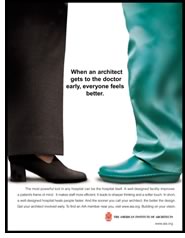
The AIA ad campaign that will roll out beginning this October nationwide brings a well-researched core message to facilities decision makers and other potential clients: "A relationship with an AIA architect from the very beginning of any built-environment discussion will help you achieve your organization's objectives and goals in ways you never expected." The May 11 presentation to convention delegates, delivered by Jamie Rice of the Institute's ad agency, Carton Donofrio, drew long and loud applause.
 The
next phase of the AIA ad campaign, funded by a special assessment approved
at the 2001 AIA convention, will run through the fall of 2004. Specific
messages have been derived and tested through a comprehensive research
program, the results of which were reported to the convention delegates.
The
next phase of the AIA ad campaign, funded by a special assessment approved
at the 2001 AIA convention, will run through the fall of 2004. Specific
messages have been derived and tested through a comprehensive research
program, the results of which were reported to the convention delegates.
The campaign will reach decision makers in the health-care, education, commercial development, government, institutional, and single- and multifamily residential markets through a combination of industry-specific (trade) magazine and network radio advertisements. The campaign objectives are to enhance understanding: of the value of design, involving architects early, and architect involvement in community; the range of projects enhanced by architects; that architects contribute to strategic planning; and the value of "AIA" as a credential.
Client research
To reach a better understanding of the dynamics driving the client/architect
relationship, the AIA launched an independent research effort whereby
anthropologists conducted 60- to 90-minute one-on-one interviews with
81 decision makers in government, institutions, commercial enterprises,
and residential development, as well as single-family homeowners. A committee
of architect-advisors monitored the gathering and interpretation of the
research findings.
In each sector (excluding single-family residential), interviews were with the leadership level of the organization (e.g., mayor or CEO); individuals involved in projects on the conceptual, visionary, and operations (procurement) levels; and persons responsible for day-to-day contact with architects and project management.

Funded by the AIA-member assessment, the research is summarized in a 24-page report, "The Client Experience, 2002," which is available exclusively to AIA members both in print form and on the member-only MyAIA portal on AIA.org. The report covers the interaction of architect and client throughout the entire project process: genesis, focus, design, construction, and operation. In each phase, the client's desire for architect involvement and current level of satisfaction are noted. Additionally, the research pinpoints in each phase how the client's attitudes, biases, and perceptions affect the client/architect relationship and the project-development process. The "Opportunities" and "Barriers" sections of the report are designed to help architects improve their processes and service offerings in an increasingly demanding marketplace.
For the ad campaign, the research effort identified three distinct client mindsets: government, producers of products, and owner-operators. Other findings are that clients value strong relationships with their architects and will pay more for them. Managing and coordinating the project team is the critical task for clients. And, typically, design is a noun to clients and a verb to architects—that is, clients see a product and architects see a process.
Media strategy
The aim is to convince clients to involve AIA architects earlier and more
often, starting from the very beginning of a project all the way through
commissioning and operation. The target audiences cover each of the segments
identified above. These persons range broadly, from 35 to 64 years of
age, residing in households with an annual income of $75,000 or more,
and college graduated. With such a broad target audience, the media strategy
must concentrate spending to achieve maximum impact. It must focus on
the most efficient media and avoid fragmented expenditures. It must also
lend itself to adoption by the AIA components. Therefore, the AIA Board
agreed to rule out network/cable television.
 Network
radio news during drive time is the most cost-effective way to reach the
largest number of people in the prescribed audience, Rice told convention
delegates. The initial run of radio and trade magazine advertising will
extend from October 2002 to December 2003. The radio portion of the campaign
will run during both morning and evening drive time to 7,000–8,000
radio stations. The ads will run during network news, business and financial
news, and sports talk programs.
Network
radio news during drive time is the most cost-effective way to reach the
largest number of people in the prescribed audience, Rice told convention
delegates. The initial run of radio and trade magazine advertising will
extend from October 2002 to December 2003. The radio portion of the campaign
will run during both morning and evening drive time to 7,000–8,000
radio stations. The ads will run during network news, business and financial
news, and sports talk programs.
The print-advertising part of the campaign will include 52 insertions into trade magazines that reach each of health-care, education, commercial, government, institutional, and residential segments.
As a whole, the advertising campaign will reach 70 percent of the targeted population. Each of those persons will hear or see an AIA ad an estimated nine times.
Component tie-ins
All print and radio materials will be available in formats for use by
local and state AIA components. Further, planning and support for buying
airtime and print space will be readily available through Carton Donofrio
Partners at no cost to the component. The campaign will include targeted
Web-cast events in conjunction with AIA components and in partnership
with key segment magazines. Moreover, there will be training sessions
at the CACE annual meetings and Grassroots on how each component can maximize
the local impact of the national ad campaign.
"The Client Experience, 2002," in (a 102 kb PDF file), click here.
Copyright 2002 The American Institute of Architects. All rights reserved.
![]()
|
|
|